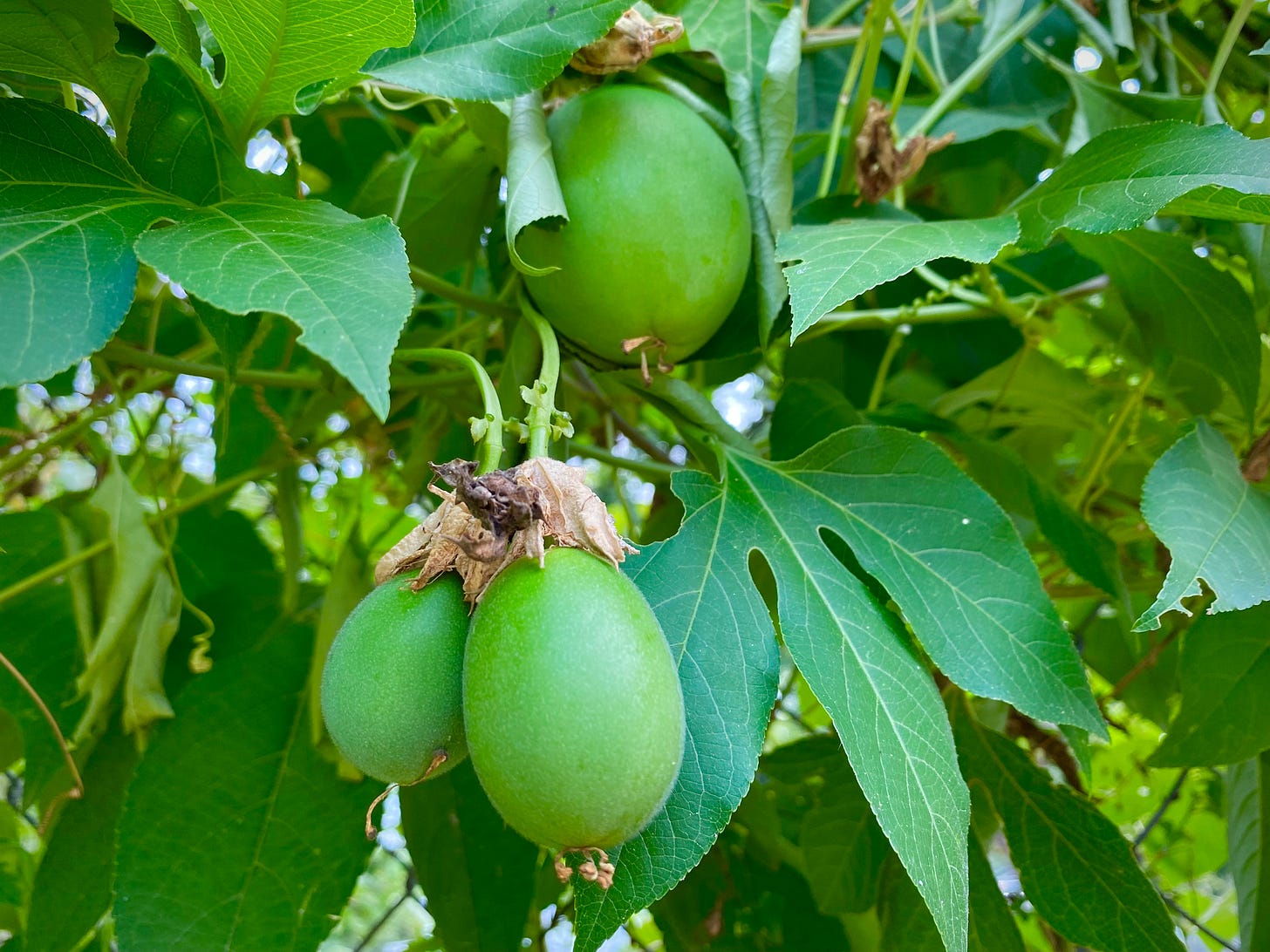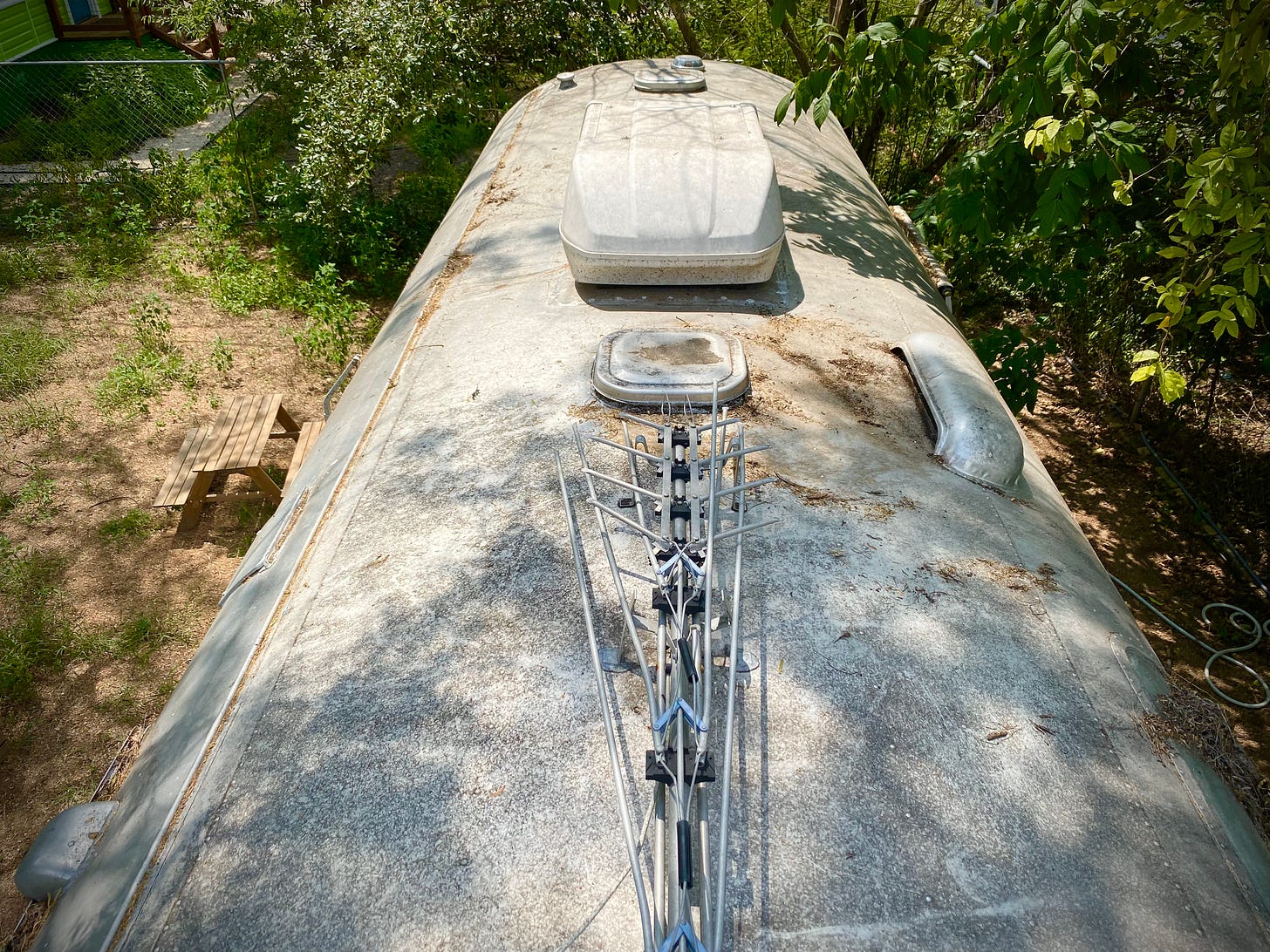The Maypops of August
This summer our front fence has been overtaken by passion vine, Passiflora incarnata, a plant with leaves like creeping ragweed and a flower that looks like it was designed by some stoner in the Star Trek art department. It appeared seemingly out of nowhere, growing up from a spot of ground that had been occupied by an invasive china berry tree we removed late in the winter. The foliage in that zone between our fence and the street is the unregulated flora of an empty lot, which this once was, and it’s interesting to see what comes and goes, and what’s native and what’s exotic.
I had never seen passion flower before, and reflexively assumed it was invasive when it started to crawl up over the wire—it has so many of the characteristics of a weed. But when I first learned what it was after posting an image on here, I learned that it is the exclusive larval host of the Gulf fritillary butterfly, a longwing that is probably the most common butterfly we see in our yard. Suggesting it has always been there, or nearby, flourishing in the untended right of way, and I just never took notice of it.
Wednesday morning I spotted one of the caterpillars munching away there in the shadows of the 18-wheelers lined up to make their deliveries at the door factory next door, and thought what a remarkable thing it is that these two species can persist in the interstices of an industrial park.
Later that day, I noticed the first fruits hanging from the vine—the things they call maypops, for the sound the purportedly hollow vessels make when crushed in your hand.
I haven’t tried to make that sound yet, but it made me wonder whether I might be able to aid in the vines’ propagation along the rest of our fenceline. Not that they need any help. This is one of those plants you get the feeling will be here long after we are gone.
Seeing that caterpillar munching away on its exclusive host to the grinding metal sounds of the nearby machine shop, I thought back to all the times over our years here that I have found fritillary cocoons hanging from unlikely places, including on that chain link where they are now growing. In the summer of 2013, before I even knew how to identify them, I found several hatching on the hubs of my old Land Cruiser. It was an expression of the essence of this place, and of the possibility of wild nature’s persistence and adaptation to the seemingly inhospitable habitat of the industrialized human city.
Reading about the plant in the excellent entry at the Wildflower Center’s Native Plants Database, I learned that its popular name does not come from its hot summer sexiness, but because our forebears divined in its elaborate structure a metaphor for the suffering of Christ:
The plants were given the name Passionflower or Passion vine because the floral parts were once said to represent aspects of the Christian crucifixion story, sometimes referred to as the Passion. The 10 petal-like parts represents the disciples of Jesus, excluding Peter and Judas; the 5 stamens the wounds Jesus received; the knob-like stigmas the nails; the fringe the crown of thorns.
As noted, the flower made me think of the space hippies episode of Star Trek rather than the New Testament, proving cathode ray wonders more effective on me than Presbyterian youth spaghetti nights, but in my defense that episode is about “The Way to Eden.”
I wonder in part if the flourishing of that vine reflects the unusually rainy summer we’ve had here in East Austin. The wet weather has also kept it on the cool side, but this week it finally felt like Texas summer, under a sun so hot that you are wary of doing anything outside after 10 am that doesn’t involve getting in the water. It’s a muggier heat than it used to be, but without the cooling benefits of being on a humid coast, so it always feels hotter than the temperature reads. The kind of heat that feels like the future we have to start getting used to. A heat that breaks things, and challenges our ability to maintain the systems that sustain this civilization devoted to the accumulation of surplus.
On Thursday afternoon I was in the middle of the fourth Zoom meeting of the day in my converted trailer office when I heard the distinctive knock of the air-conditioning conking out. It happens every year, and it’s the way I always know summer has really arrived. Error code E5, excessive temperature of the inside coil. I endured the remaining 45 minutes of the call, beginning to sweat, and when it was done the temperature registered 99 on the unit, which probably meant it was a few degrees above 100.
My friend the Denali guide once remarked to me that when it’s 40 below, you get pretty good at fixing your heater. In Texas, you get pretty good at fixing your A/C. And this one is pretty easy, when it’s mostly a matter of opening it up, letting it air out and removing any natural debris that may have accumulated on its machine surfaces.
In my most recent book, and the one I am working on now, people in these parts have to endure life without the certainty of air-conditioning, or of any reliable electrical power. That feels like a species of realism to me, not just because our own A/C often fails, in the house as well as the trailer, and we have to adapt until it can be repaired. The unreliability of the power grid is something Texans learned the hard way with cold rather than heat earlier this year, something that felt to me like further evidence of the “Third Worlding” of the USA that I have mirrored in my fiction. At the root, I think we all feel it in our gut—that an insufferably and possibly unsurvivably hot future is a bill that has come due, for the Promethean bargain our ancestors made so we could have unlimited Zoom calls.
The natural wonders I see around me here at the edge of town in a warm corner of this warming planet, like fritillaries hatching from truck hubs, have given me a reflexive optimism about nature’s ability to adapt to change, enough to balance my dismal feelings about the human future, or at least the short-term future of industrial civilization. That balance shifted a little bit on Friday, when I noticed a new fritillary cocoon in an unlikely place.
It was hanging from one of the door columns of the old shorty shipping container we keep our bikes and yard equipment in, a metal box marked with its record transporting gear to and from the faraway wars of the Oughts before its retirement to surplus in Houston. It looked like the butterfly was in the middle of its emergence, until I examined more closely and realized it had died in the process. Perhaps, I postulated, because of the insane heat that metal soaks up from the afternoon sun.
I thought about that dead butterfly when I read about the connection of its larval host plant to the Passion, but maybe that’s a metaphor too far.
Soy ink sunshine
Thursday morning, this notice appeared on page 11C of the local paper, in the back of the sports section, next to the weird zombie offerings that constitute the post-Internet classified ads (see, e.g., WE PAY CASH FOR GOLF BALLS):
Having just explored the unbelievable riparian greenbelt that surrounds the site of that air permit on Saturday, as documented here, it was a bummer to read that reminder of the pollution to come from the Tesla plant, even if it may be much less than the typical automobile factory (one wonders what contaminants are generated by the production of the batteries, which is also planned for the new plant). The bigger revelation was how outdated are the means whereby licenses to pollute and other beneficences of the state to corporate actors are put on display for public scrutiny. There may be other media in which this material is transmitted, but you can bet it all works to provide the appearance of sunshine, and the only people that read these are the few underappreciated underdogs who make it their business to do so. Imagine if, for example, every one of these had to be published on Twitter and Facebook, for the mass mob to digest.
These guys on the next page, between the crossword and the Ken Ken, probably won’t read it either way:
Die Freikörperkultur
If you believe my dad, who turned 85 (!) this week, when I was born my maternal great-grandfather, a German civil engineer who worked stints in Soviet Russia and Civil War Spain, sent my parents as congratulations a long list of recommended health supplements and a picture of himself sitting naked on a horse. He’s not the only member of the German side of the family known for a proclivity for getting naked outside, especially where cold fresh water is involved. So it was a kick for me to read this deep history of modern German nudism at The Baffler: “Nuding Out,” by Daniela Blei.
Of note: in the aftermath of the 1918 flu epidemic, which claimed 300,000 German lives, “Germans went in search of green space and fresh air; nudists went even further, exalting nature, its health-giving properties and anti-urban, anti-bourgeois character.” Probably not a breakthrough we need here in the culture that gave us entire companies devoted to men being able to keep their shirts untucked, but as an underground movement it has its appeal, even in a neighborhood like this with a lot of broken glass.
Have a safe week, and don’t emerge too soon.














Another amazing post. Thank you.